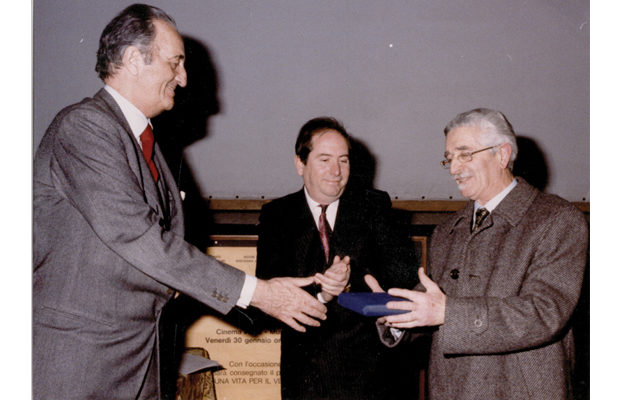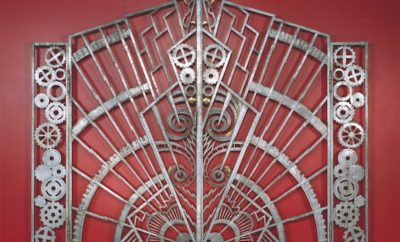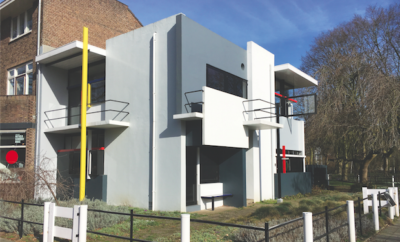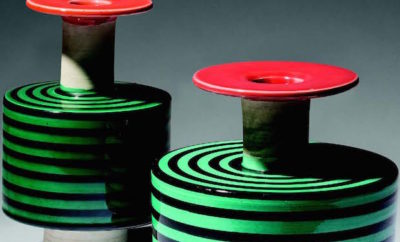
Exhibition
History Lesson: The Importance of Anzolo Fuga

Anzolo Fuga (1914–1998) on the occasion of an award from the Venetian Chamber of Commerce in 1987.
ANZOLO FUGA, BORN IN 1914, came from one of Murano’s oldest and most distinguished glassblowing lineages, dating back to the Middle Ages. His father, Emilio Fuga, was director of the Cristalleria di Venezia e Murano, which made French-style crystals that were ground or decorated with acid. His mother, Adelaide Barovier, was the daughter of Giuseppe Barovier, an important and talented glass master who worked on Murano in the late nineteenth and early twentieth centuries. Anzolo, his name the Muranese version of Angelo, was named after his paternal grandfather, who had revived the art of copper-wheel engraving and the making of decorated mirrors in the second half of the nineteenth century.
A talented young artist specializing in illustration, lithography, and watercolors, Anzolo attended the Istituto d’Arte di Venezia, a prestigious high school for the arts where the teachers were artists themselves and often experts in glassmaking. There he developed a serious interest in stained glass, which at the time was typically made using large sheets of homogenous glass. Fuga, however, was fascinated with the subtleties and artistic qualities he could achieve by incorporating the fragments of hand-blown glass that were routinely discarded at glasshouses. In 1938 he started a new stained-glass department within the Istituto and went on to dedicate much of his life to the creation of stained-glass panels, each a work of art.
He used glass fragments, murrhines, and glass rods fused with lead, all worked hot, and sometimes engraved the panels with acid for added effect. His panels were often exhibited at biennales and other exhibitions and can be seen today in numerous Catholic churches in Venice, a chapel in Australia, a synagogue in Jerusalem, and in the Palazzo Barbarigo and the Hotel Danieli in Venice. It was at this last where I first became enthralled by his work.

Vase, 1955–1968, incorporating glass fragments, murrhines, and rods—all elements Fuga also used in his stained- glass windows.
Fuga was also a talented designer of glass vases and other objects. He and his brother Giuseppe collaborated on pieces decorated with enamel and gold that were extremely sophisticated and emblematic of the 1950s. Incorporating complex abstract designs that required a high degree of technical skill, these pieces were routinely exhibited at the Fondazione Bevilacqua La Masa, a prestigious applied arts exhibition in Venice, and are highly sought after today.
From 1955 through 1968 Fuga designed glass for one of the most important glass houses on Murano, Arte Vetraria Muranese (or A.V.E.M.), which was owned by Ada Ferro, the only female owner and manager of a glass house in the 1950s and 1960s. Normally, a glasshouse designer created a limited number of pieces. Clients would see the model in the showroom and buy it. Then the glasshouse would make another and it would be available to the next buyer. Fuga had a different arrangement: a true artist, he wanted to be able to experiment with different models at all times, so he would show up at A.V.E.M. with drawings and ideas on a daily basis. He and Ferro’s younger brother Luciano (and sometimes other blowers) would figure out the best way to carry out the designs, almost all of which were executed by Luciano. There were rarely two identical pieces; instead there were many variations on a theme, some pieces very delicate and others extremely bold.

Detail of stained-glass windows by Fuga in the chapel at Scalabrini Village, a retirement center catering in particular to the Italian community in southwestern Australia. The chapel appears to have been built in the 1960s or 1970s.
After these pieces were completed, Ada Ferro would whisk them into storage rooms at A.V.E.M., considering them valuable avant-garde art objects that she wanted to keep. According to her widower, Gianfranco Zabot, Ferro was a private and protective woman who felt that if people saw Fuga’s work they would copy it, as was common on Murano. There are stories from the glassblowers at A.V.E.M. of her kicking people out of the glasshouse because she was convinced they were spying on Fuga’s designs. Moreover, she was extremely close to Luciano, who died at forty-seven, and was reluctant to sell the pieces he blew. This created a unique situation: a large body of work by an important glass designer was hidden from view. A.V.E.M. kept most of Fuga’s designs locked away for decades.
Indeed, when I first started researching Fuga’s designs and found that he had worked at A.V.E.M. over a long period, I was surprised that I could not find many pieces for sale. Occasionally, but infrequently, a vase or bowl would show up at auction. Around 2001 I came to know a glass dealer in Venice who told me about the hundreds of pieces by Fuga, Giulio Radi, and others in storage at A.V.E.M. He arranged for me to meet Zabot and to see the collection. Zabot explained that since the pieces had been highly prized by his wife he did not want to sell them. As we talked over the course of that week, however, I gained his trust, and he agreed to sell me a large part of the collection on the condition that I would do my best to get a noteworthy book published about it. I gave him my word that I would do so.

This is a rare example of what Fuga called a “Radici” (Roots) vase on a drawing for the series, 1960–1961.
Every serious glass collector and museum curator of decorative arts knows that the most respected Italian glass historian in the world today is Rosa Barovier Mentasti, who has spent her life in Venice and on Murano studying the history of glass and glassmaking and has written many essential books on the subject. What most people do not know is that Anzolo Fuga was her teacher at the Scuola del Vetro Abate Zanetti (Abate Zanetti Glassmaker’s School), where he was also director from 1951 to 1972. Mentasti had visited A.V.E.M. in the 1970s and Ferro had shown her the works she had by Fuga and Radi; at that point Mentasti expressed interest in doing a book on them, but Ferro would not consent. When I approached her in 2002 about a monograph on Fuga and this particular cache of works, I was thrilled that she agreed. Aware that her most valuable asset was her reputation as an independent researcher and historian, Mentasti insist- ed on full control over the contents of the book—though she allowed me to write the foreword and be involved in the photography and layout. Zabot granted her full access to the A.V.E.M. archives and she interviewed all the glassblowers who had worked there in the 1950s and 1960s and afterwards to authenticate each piece as Fuga’s design and to make sure that none had been made after he left in 1968. She would not accept payment for the book, believing that Fuga was so important that it was her obligation to educate the world about him.

Both vases demonstrate the colorful “windows” Fuga incorporated into his pieces, one window created with rods and the other with murrhines, 1955–1956.
After two years of research Mentasti’s Anzolo Fuga: Murano Glass Artist, Designs for A.V.E.M., 1955–1968 was published by Acanthus Press in 2005. Most of the works included had never been seen before, and almost all the information it contains was groundbreaking. As she wrote in the book, Fuga’s pieces were extraordinarily modern for his time and “possess a chromatic and decorative impact that still appear exceptional today. His works speak the language of the 1950’s and 60’s with such freshness that they do not look out-of-date in the most contemporary of environments.” Some of his pieces have “windows” as part of their design. One of his better-known designs, the Bandiere (Flag) series was so-named because of the way the colorful rods were laid out when the pieces were constructed, as the glass masters explained to Mentasti. At least one vase was unlike anything anyone had seen before, with a thin thread-like element that extended from one wall of the vase to the other; Rosa had to consult the blowers to find out how it was made. Ironically, such pieces can’t be used as vases since the most complicated design elements, the glass threads, would break. Another series incorporates glass fragments, murrhines, and rods as Fuga was doing in his stained-glass windows.
Anzolo Fuga died in 1998 and Murano lost one of the most creative and artistic minds of the twentieth century. Thankfully, we have Rosa Barovier Mentasti’s extraordinary tome documenting his achievements at A.V.E.M. Just a hint at what he created is presented here.












